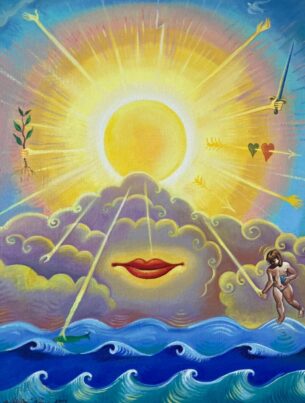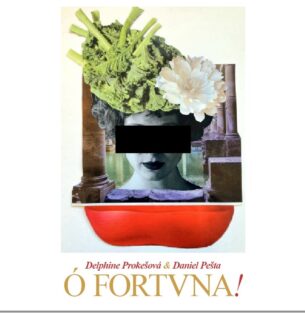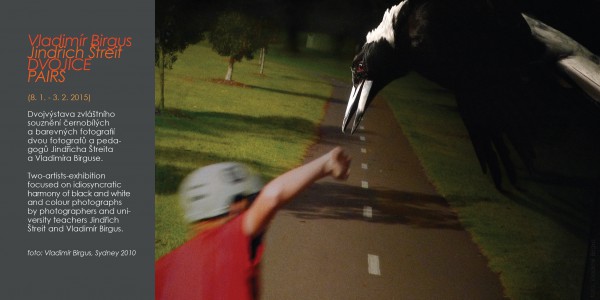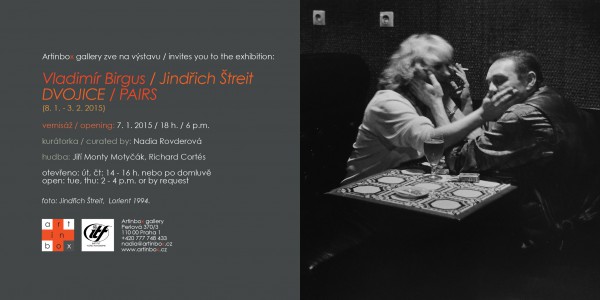Vladimír Birgus, Jindřich Štreit
(8. 1.–3. 2. 2015)
Dvojvýstava zvláštního souznění černobílých a barevných fotografií dvou fotografů a pedagogů Jindřicha Štreita a Vladimíra Birguse.
A double exhibition showing the unusual concordance between the black-and-white and colour photographs of Jindřich Štreit and Vladimír Birgus.
kurátorka / curator: Nadia Rovderová
technická spolupráce / technical cooperation: Antonín Vrňák, Lucie Černá, Dana Michlová
překlady / translations: Stephan von Pohl
Výstava je pořádána ve spolupráci s Instituten tvůrčí fotografie Slezské univerzity v Opavě.
Exhibition is organized in cooperation with Institute of Creative Photography, Silesian University in Opava.
hudba / music: Jiří Monty Motyčák, Richard Cortes
událost na facebooku můžete sledovat a účast potvrdit zde:https://www.facebook.com/events/584455358351444/
fotografie z vernisáže a instalace výstavy jsou ke shlédnutí zde: https://www.facebook.com/media/set/?set=a.768473263225364.1073741861.100551130017584&type=3
Tvorbu dvou fotografů a pedagogů Vladimíra Birguse a Jindřicha Štreita jsem pro tuto výstavu nevybrala náhodně. Na první pohled jsou to dva odlišné celky, na ten druhý pohled poznáme, že jsou to dvě součásti celku jednoho. Proto tak dobře souzní fotografie barevné snímané povětšinou v kulisách světových velkoměst od Vladimíra Birguse a snímky černobílé z prostředí venkova – českého, moravského i francouzského od Jindřicha Štreita.
Oba autory spojuje příklon k dokumentární fotografii. Jak ve městě, tak na venkově se odehrávají příběhy. Na venkově jsou si lidé o něco blíž, taky fotograf se k nim víc přibližuje, jakoby byl přímo součástí jejich soukromí. Vztahy dvojic jsou tu jasně dané: Milenci. Partneři v očekávání potomka. Matka a dítě. Modlící se kněz u sochy Spasitele na kříži. Kněz a křtěný. Opilí kamarádi u piva. Dva zaměstnanci pohřebního ústavu nesou máry po zesnulém…
Ve velkoměstech plných lidí jakoby se jednotlivci od sebe spíš vzdalovali. Nebo nám jenom víc skrývají to, co mezi nimi probíhá. Jsou to dvě v průsečíku se potkávající přímky, či dvě paralelně běžící čáry? Jak jeden druhého ovlivňuje, co mu přináší či bere? Co je mezi těma dvěma? Láska? Přátelství? Pokrevní vztah? Nic?
Interakce mezi aktéry na barevných snímcích Vladimíra Birguse jsou nám jakoby dobře známé. Prodavačka a nakupující. Žebrák a kolemjdoucí. Pán a pes. Pes a pes. Kluk a pták. Člověk a jeho stín.
Co to však je, co nás znepokojuje, nutí ty obrazy zkoumat? Ty snímky dávají prostor imaginaci, skrývají tajemství. Dvě míjející se ženy v newyorské ulici, ani jedné nevidíme do tváře, ale červený kabát a šarmantní silueta u jedné a černý kabát a čepice a unavený shrbený postoj u druhé naznačují míjející se mládí a stáří.
Někde jen interiéry, exteriéry či předměty v nich, potichu svědčí o tom, co zde asi prožívali jejich uživatelé. Člověk je zde všudypřítomný, i když absentující či anonymní….
Propojením těchto dvou různých formálních i obsahových přístupů vzniká zvláštní napětí. Interakce dvou pohledů na vztahy mezilidské, na vztahy se světem kolem nás i na vztah se sebou samým, vytváří atmosféru, jenž nás vtahuje do zamyšlení nad tím, kde v tomto světě je to naše místo, s kým to místo sdílíme, kdo vlastně jsme, kam, s kým a proč směřujeme…
Nadia Rovderová, Praha, leden 2015
English——————————————————-
My choice of photographs by these two photographers and professors was not by chance. At first glance, their works comprise two independent units, but a second glance reveals that they are two parts of the same whole. For this reason, Vladimír Birgus’s colour photographs, taken for the most part on the streets of the world’s large metropolises, resonate so well with Jindřich Štreit’s black-and-white images of the Bohemian, Moravian, and French countryside.
Both artists share an inclination towards documentary photography. The stories take place both in the city and in the countryside. The rural pairs are somewhat closer to one another, and the photographer is closer to them as well, becoming almost a direct part of their private lives. People’s relationships are clearly defined: Lovers. Partners expecting their offspring. Mother and child. A priest praying by a statue of the Saviour on the cross. Priest and baptized child. Drunken friends with their beers. Two workers at a funeral home carrying a bier with the deceased…
The big cities are full of people, individuals who remain distant from one another or who are better at hiding what goes on between them. Are they parallel lines or two intersecting vectors? How does one influence the other; what does he bring for or take from the other? What is going on between those two? Love? Friendship? Blood ties? Nothing?
The interactions between the people in Birgus’s colour photoraphs strike us as familiar. A sales clerk and a shopper. A beggar and passers-by. A man and his dog. Dog and dog. A boy and a bird. A man and his shadow.
But what is it that unsettles us and forces us to explore these images? The photographs give the imagination free rein. They contain mysteries. Two women passing each other on a New York street. We see neither woman’s face, but one woman’s red coat and debonnaire silhouette and the other’s black coat and hat and tired, bent figure subtly and clearly indicate youth and old age.
Sometimes the interiors, exteriors, or items in the photographs provide a silent testimony as to what their users might have experienced. Man is omnipresent even when absent or anonymous.
These different approaches to form and content combine to produce a strange tension. The interaction of these two ways of looking at interpersonal relations, at our relationship to ourselves and to the world around us, creates an atmosphere that encourages us to consider our place in this world, who we share this place with, who we are, and where we are headed, with whom and why…
Nadia Rovderová, Prague, January 2015




